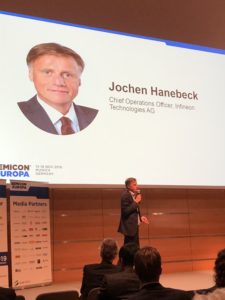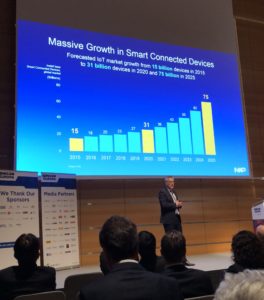In the past 10 weeks, I’ve attended five conferences: two in Europe, and three in California. Two focused on MEMS and sensors, two on advanced packaging, and one that tied everything all together.
At all of these events, the themes were consistent: advanced packaging rules; automotive and IoT is driving the train, and artificial intelligence and machine learning are the ones to watch on the hype cycle.
This past week, there was a lot of ground to cover (literally and figuratively) at SEMICON Europa and Electronica, which brought the entire electronics supply chain under one (massive) roof at Munich’s Messestadt.
In three days, I logged 29.4 miles (that’s a whopping 47,366 steps, for all you fitness trackers out there). I sat through the keynote talks and (another) women’s panel on diversity and inclusion, visited as many exhibitors as I could cram in, and attended a bunch of booth parties. (Hopefully, the steps offset all the food eating and beer drinking.) Here are the highlights.
Semiconductors Drive “Smart”
At SEMICON Europa 2018, the stories SEMI has been telling over the past year haven’t changed a whole lot:
- Tremendous growth is expected – Ajit Manocha says we can expect today’s $.5T in IC issues to double to $1T in the next 10 years.
- The shortage of talent is a barrier to growth around the world
- Semiconductors provide the foundation for a plethora of market and technology drivers collectively dubbed “Smart”- the internet of things (IoT) autonomous vehicles, artificial intelligence (AI), and machine learning (ML).
- The data explosion will continue and is expected to reach 1ZB by 2025
- AI and ML need high performance and low power
Add to that:
- How the US/China trade wars will impact growth; the story is different for the US and Europe.
- There’s a new realization and focus on the importance of building in security and privacy. This is especially critical for automotive applications as well as IoT applications.
- There’s more discussion about edge computing vs. cloud
As Trade War Looms
“Last year it was party time: growth, growth, growth,” said Jochen Hanebeck, COO, Infineon. “This year, we’re not as optimistic. Trade wars are a big deal.”

Infineon’s answer to the situation? According to Hanebeck, the company is building a 1.6B semiconductor fab in Villach, Austria. For Infineon, growth is unabated, he said. Across all markets, from data centers to home appliances, the need for energy efficiencies in power semiconductors is sparking particular growth in power semiconductors. Hanebeck says Infineon’s competitive advantage is its thin wafer technology, developed in Europe.
Some of the suppliers I spoke with described the looming trade wars as an advantage for those not heavily invested in supporting HVM in mainland China. Rather, they say it will shift both manufacturing and R&D to the US and Europe. The only difference for them willl be the shipping address for their tool.
My take? The US and Europe have always been leaders in R&D. And as China is still the largest consumer of integrated circuits, a US-China trade war will negatively impact industry growth.

The Crown Jewels of Europe
“Automotive electronics are the crown jewels of Europe,” declared Laith Altimime, president, SEMI Europe. That’s why NXP’s Kurt Sievers and Audi’s Thomas Muller were invited to deliver kick-off keynotes.
Sievers’ talk focused on the IoT enabled by AI and ML, as it applies to autonomous vehicles, stressing the importance of safe and secure mobility.
The IoT is growing slower than market forecasters predicted five years ago, noted Sievers. While the technology is there, the business and ecosystem are just starting to ramp up.
“IoT enabled by AI will be as transformational to our lives as the internet has been for the past 10-20 years,” he predicted. “But AI is being overhyped. In my view, it’s still in its infancy. For example, Google translator doesn’t understand a single word or phrase of what it is translating. Conceptual awareness and intelligence are still way behind human beings. This is a big opportunity for us.”
Likewise, he compared today’s machine learning to “spreadsheets on steroids.” ML is an enabler of AI but is also over hyped. It requires a massive amount of computing power.

Computing Moves from Cloud the Edge
High performance, low power compute platforms are bringing AI from the cloud to the edge, which is critical for privacy and security, noted Sievers because there is more risk when transferring data from computers to the cloud. The IoT creates a field of risk, as each IoT end node provides a hacking possibility.
The risk of privacy breaches is especially high in China, where the sharing economy is ubiquitous, and the amount of individual data produced is enormous. “It’s super important to build in security,” said Sievers. Music to my ears.
Computing at the edge reduces this risk. “Machine learning in edge computing will make a big difference in the growth curve of the IoT,” says Sievers. “Functional safety is the name of the game.”
Safe and Secure
Cars, as one node in the IoT, are starting to generate incredible amounts of data. This is another great example of where edge computing is needed, said Sievers. The processing has to take place in the car for the vehicle to react in time. Additionally, all this data requires bandwidths only available in 5G.
“These performance requirements directly translate into IC value,” said Sievers. “But I’m not just excited about the IC value. What it does for the world is equally exciting.” The vision NXP is pursuing with its automotive electronics is zero emissions, zero accidents, and zero congestion.
A New Collaboration Model
Thomas Muller, Audi, offered the consumer and OEM perspective. He showcased Audi’s prototype autonomous vehicle, the Aicon, calling it a laptop and a battery on wheels.
The next era of driving will be more about how costumers experience the car, he said. The AICON includes a personal intelligence assistant (PIA) that gives the car personality. The car resembles a lounge where you can comfortably watch a movie or check email while you’re traveling to your destination.
Achieving this vision of the consumer car experience requires a new collaboration model. He suggests cross-industry collaboration, cross-value chain collaboration, and industry “co-opetition”. Establishing a cross-industry environment is the key to accelerating the speed of innovation.
Making the Impossible Possible
In his keynote, imec’s Luc van den hove provided inspiration for the future by suggesting that we think beyond what we know is essential and dare to look at things from an unusual perspective. He talked about things being worked on today that would have been impossible not too long ago:
- CRISPR technology: gene editing that cures diseases caused by mutations in the human genome.
- Development of a multi-electrode array chip (MEA) that is used for precise cell reprogramming and shows promise for treating dementia.
- Adding touch sensors to display functions by integrating massive amounts of actuators in a thin film display. These can be used for fast eye tracking systems, to improve user experience in augmented and virtual reality applications and can be used in health care applications for early detection of neurogenerative diseases.
- Development of a low-power neuromorphic chip using cross-bar memory technology to create low-power AI engines that operate in a similar manner as the human brain.
It’s All About Data
By 2025, noted Van den hove, we will need energy sources that can support one zettabyte of data. This will require smarter methods for computing, storing and connecting data. Imec is exploring FINFET technology using nanowires to achieve sub 3µm technology nodes.
With extreme ultraviolet (EUV) lithography expected to ramp to volume manufacturing in the next year, he predicted a re-acceleration of the scaling roadmap.
It’s also about the architecture. Van den hove says development of next-generation devices will be in the hands of system experts. He talked about quantum computing, which in 10-15 years time will outperform supercomputing.
Don’t be surprised if the solution for high-density and long-term data storage, with the ability to archive and retrieve, will be done using DNA molecules. Van den hove says they are extremely stable, and development of read-write capabilities for DNA is possible.
“By crosslinking expertise from various areas and bringing together bright minds from various disciplines we can create new innovation,” said Van den hove. “Only by thinking big and looking at things from a different angle, can we make the impossible possible.”
And with that inspiration to launch SEMICON Europa 2018, I set off to explore the exhibit halls. Stay tuned for more. ~ FvT





















